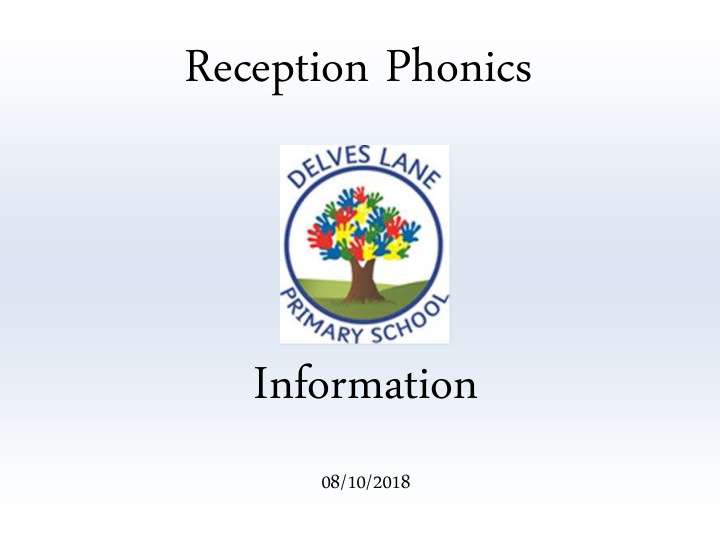



Reception Phonics Information 08/10/2018
Phonic onic skills lls Your child has a 20 minute phonics lesson every day. This involves learning letter sounds and shapes, hearing and saying the sounds in words in the correct order as well as being well on the way to being able to read and write the 44 phonemes (sounds) in the English language. We follow a program called Letters and Sounds and teach the children by using Jolly Phonics which some of your children will have started at nursery or pre-school. Once your child has learnt some of the 44 phonemes they will be taught how to blend these together (put them together) to read simple words.
44 44 phonemes onemes It is important for children to learn the correct pronunciation of each sound e.g. sss not ‘ suh ’, mmm not ‘ muh ’ Video examples can be found on YouTube – search Jolly Phonics songs in order
Blendi ding ng Once children begin learning their sounds we encourage them to blend words straight away to develop reading skills. s – a – t sat
Sou ound nd boo ooks Children will be given sound books containing the sounds we have learnt to practise at home. Please make sure these books are in their bags everyday so we can practise at school and add new sounds as we learn them.
Action ion words rds We will also teach children to read high frequency words. Every few weeks they will bring as set of five words home to learn along with ideas for games to play with them. Some of these words cannot be blended and are learned by sight. These are known as tric icky ky words rds. If children learn to recognise and read these words it will help them to become a fluent reader. Look-cover-write-check. my said
Reading ng books Over the next few weeks, your child will start to bring home a ‘reading’ book. These first books will have no words so that your child can learn to use the pictures to tell a story. This is an important phase of learning to read. Please encourage your child to talk about the books in sentences. Once your child is able to use pictures to tell the story and is beginning to recognise a large proportion of the sounds and blend them together we will move them onto levelled reading books. We use many different reading schemes but all are levelled into colour bands according to their ease of reading. Do not worry if your child cannot read all of the words in their books. Read the difficult words for them and encourage them to use the pictures to help them. Please let us know how they get on with their reading by using their reading diary.
The te teaching hing and d practice tice of of read ading ing The teaching and practice of reading takes place in a variety of ways: • Shared reading where the teacher models good reading practise to the whole class. • Individual reading practice might be with the teacher or teaching assistant.
Wider er reading ding skil ills ls In addition to phonics, your child will also start learning comprehension skills, understanding story sequences, structure, language and characters. They will also look at different types of texts: story, information, poetry. Your child should become more familiar with how a book works; that the words carry meaning and that we read from left to right and from top to bottom.
Reading ng linked d to writing ing Children’s first writing is called ‘mark making’. Children are encouraged to ‘have a go’ at writing at tell an adult about what they have written. Once children begin to blend sounds to read words, they can begin to say the sounds needed to write simple words and are encouraged to have a go at this from early on. We encourage your child to hold their pencil or pen correctly and show them the correct formation for each letter.
Ho How yo you ca u can n hel elp • Make sure children have their school bags everyday • Practise sound books and word boxes at home • Please sign reading logs when you have heard children read so we can change them
Writing is fun…and messy!!
Recommend
More recommend